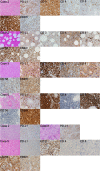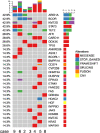Combination of anti-PD-1 antibody with P-GEMOX as a potentially effective immunochemotherapy for advanced natural killer/T cell lymphoma
- PMID: 33376237
- PMCID: PMC7772337
- DOI: 10.1038/s41392-020-00331-3
Combination of anti-PD-1 antibody with P-GEMOX as a potentially effective immunochemotherapy for advanced natural killer/T cell lymphoma
Abstract
Advanced natural killer/T cell lymphoma (NKTL) has demonstrated poor prognosis with currently available therapies. Here, we report the efficacy of anti-programmed death 1 (PD-1) antibody with the P-GEMOX (pegaspargase, gemcitabine, and oxaliplatin) regimen in advanced NKTL. Nine patients underwent six 21-day cycles of anti-PD-1 antibody (day 1), pegaspargase 2000 U/m2 (day 1), gemcitabine 1 g/m2 (days 1 and 8) and oxaliplatin 130 mg/m2 (day 1), followed by anti-PD-1 antibody maintenance every 3 weeks. Programmed death-ligand 1 (PD-L1) expression and genetic alterations were determined in paraffin-embedded pretreatment tissue samples using immunohistochemistry and next-generation sequencing (NGS) analysis. Responses were assessed using 18F-fluorodeoxyglucose positron emission tomography (18FDG-PET) and computed tomography or magnetic resonance imaging. Eight patients exhibited significant responses, comprising of seven complete remissions and one partial remission (overall response rate: 88.9%). After a median follow-up of 10.6 months, 6/9 patients (66.7%) remained in complete remission. The most common grade 3/4 adverse events were anemia (33.3%), neutropenia (33.3%), and thrombocytopenia (33.3%); all of which were manageable and resolved. Immunochemotherapy produced a high response rate in patients with positive PD-L1 expression (5/6, 83.3%). NGS analysis suggested that STAT3/JAK3/PD-L1 alterations and ARID1A mutation were associated with immunochemotherapy efficacy. Mutation in DDX3X and alteration in epigenetic modifiers of KMT2D, TET2, and BCORL1 might indicate a poor response to immunochemotherapy. In conclusion, the anti-PD-1 antibody plus P-GEMOX regimen demonstrated promising efficacy in advanced NKTL. PD-L1 expression combined with specific genetic alterations could be used as potential biomarkers to predict therapeutic responses to immunochemotherapy.
Conflict of interest statement
The authors declare no competing interests.
Figures




References
Publication types
MeSH terms
Substances
LinkOut - more resources
Full Text Sources
Research Materials
Miscellaneous

